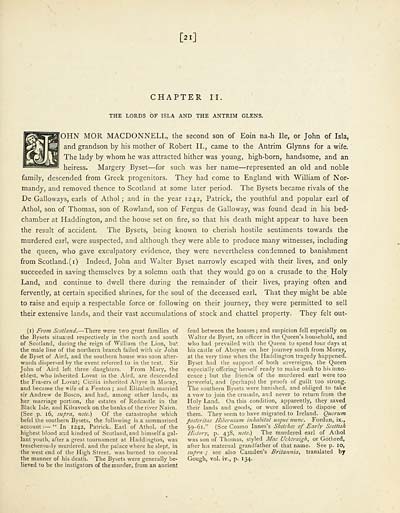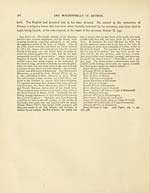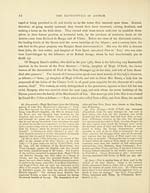Historical account of the Macdonnells of Antrim
(35) Page 21 - Lords of Isla and the Antrim Glynns
Download files
Complete book:
Individual page:
Thumbnail gallery: Grid view | List view

[21]
CHAPTER II.
THE LORDS OF ISLA AND THE ANTRIM GLENS.
j]OHN MOR MACDONNELL, the second son of Eoin na-h He, or John of Isla,
and grandson by his mother of Robert II., came to the Antrim Glynns for a wife.
The lady by whom he was attracted hither was young, high-born, handsome, and an
heiress. Margery Byset — for such was her name — represented an old and noble
family, descended from Greek progenitors. They had come to England with William of Nor-
mandy, and removed thence to Scotland at some later period. The Bysets became rivals of the
De Galloways, earls of Athol ; and in the year 1242, Patrick, the youthful and popular earl of
Athol, son of Thomas, son of Rowland, son of Fergus de Galloway, was found dead in his bed-
chamber at Haddington, and the house set on fire, so that his death might appear to have been
the result of accident. The Bysets, being known to cherish hostile sentiments towards the
murdered earl, were suspected, and although they were able to produce many witnesses, including
the queen, who gave exculpatory evidence, they were nevertheless condemned to banishment
from Scotland.(i) Indeed, John and Walter Byset narrowly escaped with their lives, and only
succeeded in saving themselves by a solemn oath that they would go on a crusade to the Holy
Land, and continue to dwell there during the remainder of their lives, praying often and
fervently, at certain specified shrines, for the soul of the deceased earl. That they might be able
to raise and equip a respectable force or following on their journey, they were permitted to sell
their extensive lands, and their vast accumulations of stock and chattel property. They felt out-
(1) From Scotland. — There were two great families of
the Bysets situated respectively in the north and south
of Scotland, during the reign of William the Lion, but
the male line of the northern branch failed with sir John
de Byset of Aird, and the southern house was soon after-
wards dispersed by the event referred to in the text. Sir
John of Aird left three daughters. From Mary, the
eldest, who inherited Lovat in the Aird, are descended
the F lasers of Lovat; Cicilia inherited Altyre in Moray,
and became the wife of a Fenton ; and Elizabeth married
sir Andrew de Bosco, and had, among other lands, as
her marriage portion, the estates of Redcastle in the
Black Isle, and Kilravock on the banks of the river Nairn.
(See p. 16, supra, note.) Of the catastrophe which
befel the southern Bysets, the following is a summarised
account: — " In 1242, Patrick, Earl of Athol, of the
highest blood and kindred of Scotland, and himself a gal-
lant youth, after a great tournament at Haddington, was
treacherously murdered, and the palace where he slept, in
the west end of the High Street, was burned to conceal
the manner of his death. The Bysets were generally be-
lieved to be the instigators of the murder, from an ancient
feud between the houses; and suspicion fell especially on
Walter de Byset, an officer in the Queen's household, and
who had prevailed with the Queen to spend four days at
his castle of Aboyne on her journey south from Moray,
at the very time when the Haddington tragedy happened.
Byset had the support of both sovereigns, the Queen
especially offering herself ready to make oath to his inno-
cence ; but the friends of the murdered earl were too
powerful, and (perhaps) the proofs of guilt too strong.
The southern Bysets were banished, and obliged to take
a vow to join the crusade, and never to return from the
Holy Land. On this condition, apparently, they saved
their lands and goods, or were allowed to dispose of
them. They seem to have migrated to Ireland. Quorum
posteritas Hiberniam inhabitat usque nunc. Fordun, ix.,
59-61." (See Cosmo Innes's Sketches of Early Scottish
History, p. 438, note.) The murdered earl of Athol
was son of Thomas, styled Mac Uchtraigh, or Gothred,
after his maternal grandfather of that name. See p. 10,
supra ; see also Camden's Britannia, translated by
Gough, vol. iv., p. 134.
CHAPTER II.
THE LORDS OF ISLA AND THE ANTRIM GLENS.
j]OHN MOR MACDONNELL, the second son of Eoin na-h He, or John of Isla,
and grandson by his mother of Robert II., came to the Antrim Glynns for a wife.
The lady by whom he was attracted hither was young, high-born, handsome, and an
heiress. Margery Byset — for such was her name — represented an old and noble
family, descended from Greek progenitors. They had come to England with William of Nor-
mandy, and removed thence to Scotland at some later period. The Bysets became rivals of the
De Galloways, earls of Athol ; and in the year 1242, Patrick, the youthful and popular earl of
Athol, son of Thomas, son of Rowland, son of Fergus de Galloway, was found dead in his bed-
chamber at Haddington, and the house set on fire, so that his death might appear to have been
the result of accident. The Bysets, being known to cherish hostile sentiments towards the
murdered earl, were suspected, and although they were able to produce many witnesses, including
the queen, who gave exculpatory evidence, they were nevertheless condemned to banishment
from Scotland.(i) Indeed, John and Walter Byset narrowly escaped with their lives, and only
succeeded in saving themselves by a solemn oath that they would go on a crusade to the Holy
Land, and continue to dwell there during the remainder of their lives, praying often and
fervently, at certain specified shrines, for the soul of the deceased earl. That they might be able
to raise and equip a respectable force or following on their journey, they were permitted to sell
their extensive lands, and their vast accumulations of stock and chattel property. They felt out-
(1) From Scotland. — There were two great families of
the Bysets situated respectively in the north and south
of Scotland, during the reign of William the Lion, but
the male line of the northern branch failed with sir John
de Byset of Aird, and the southern house was soon after-
wards dispersed by the event referred to in the text. Sir
John of Aird left three daughters. From Mary, the
eldest, who inherited Lovat in the Aird, are descended
the F lasers of Lovat; Cicilia inherited Altyre in Moray,
and became the wife of a Fenton ; and Elizabeth married
sir Andrew de Bosco, and had, among other lands, as
her marriage portion, the estates of Redcastle in the
Black Isle, and Kilravock on the banks of the river Nairn.
(See p. 16, supra, note.) Of the catastrophe which
befel the southern Bysets, the following is a summarised
account: — " In 1242, Patrick, Earl of Athol, of the
highest blood and kindred of Scotland, and himself a gal-
lant youth, after a great tournament at Haddington, was
treacherously murdered, and the palace where he slept, in
the west end of the High Street, was burned to conceal
the manner of his death. The Bysets were generally be-
lieved to be the instigators of the murder, from an ancient
feud between the houses; and suspicion fell especially on
Walter de Byset, an officer in the Queen's household, and
who had prevailed with the Queen to spend four days at
his castle of Aboyne on her journey south from Moray,
at the very time when the Haddington tragedy happened.
Byset had the support of both sovereigns, the Queen
especially offering herself ready to make oath to his inno-
cence ; but the friends of the murdered earl were too
powerful, and (perhaps) the proofs of guilt too strong.
The southern Bysets were banished, and obliged to take
a vow to join the crusade, and never to return from the
Holy Land. On this condition, apparently, they saved
their lands and goods, or were allowed to dispose of
them. They seem to have migrated to Ireland. Quorum
posteritas Hiberniam inhabitat usque nunc. Fordun, ix.,
59-61." (See Cosmo Innes's Sketches of Early Scottish
History, p. 438, note.) The murdered earl of Athol
was son of Thomas, styled Mac Uchtraigh, or Gothred,
after his maternal grandfather of that name. See p. 10,
supra ; see also Camden's Britannia, translated by
Gough, vol. iv., p. 134.
Set display mode to:
![]() Universal Viewer |
Universal Viewer | ![]() Mirador |
Large image | Transcription
Mirador |
Large image | Transcription
Images and transcriptions on this page, including medium image downloads, may be used under the Creative Commons Attribution 4.0 International Licence unless otherwise stated. ![]()
| Histories of Scottish families > Historical account of the Macdonnells of Antrim > (35) Page 21 - Lords of Isla and the Antrim Glynns |
|---|
| Permanent URL | https://digital.nls.uk/95341667 |
|---|
| Description | A selection of almost 400 printed items relating to the history of Scottish families, mostly dating from the 19th and early 20th centuries. Includes memoirs, genealogies and clan histories, with a few produced by emigrant families. The earliest family history goes back to AD 916. |
|---|

